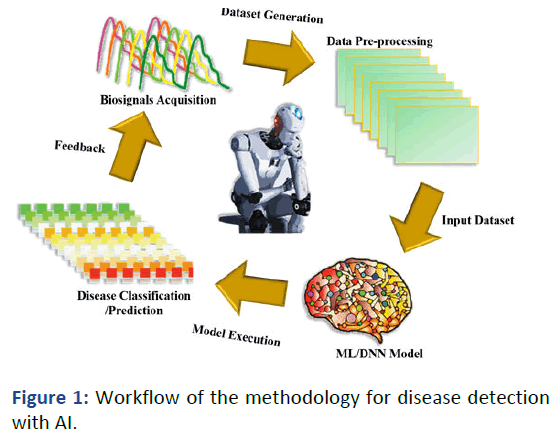Short Communication - (2023) Volume 14, Issue 9
Received: 27-Apr-2023, Manuscript No. aasrfc-23-17669; Editor assigned: 02-May-2023, Pre QC No. aasrfc-23-17669 (PQ); Reviewed: 16-May-2023, QC No. aasrfc-23-17669; Revised: 18-Aug-2023, Manuscript No. aasrfc-23-17669 (R); Published: 15-Sep-2023
The analysis of biosignals acquired from different body postures has emerged as a valuable source of information for early assessment of various physiological, kinesiological, anatomical and neurological disorders such as hypertension, tumours, parkinson's disease, multiple sclerosis and joint abnormalities to name few [1,2]. However, existing technologies for capturing it, have several limitations such as low latencies, bulky size, high costs and power consumption. In this context, the introduction of a highly sensitive, conformable and flexible wearable gadget makes it a promising solution to address these challenges [3-5].
The inclusion of the self-powered sensors in wearable gadget offers high-end properties such as convenience, longevity, cost-effectiveness, sustainability and increased functionality. By utilizing the principles of piezoelectricity, triboelectricity, and flexoelectricity, self-powered wearable sensors operate without the need for external power sources, which makes wearable devices smaller, lightweight and more convenient for users [6]. Rather these employ the daily activities such as walking, running, talking and temperature change for getting powered. Additionally, these are also very promising for energy harvesting applications, which can able to generate the energy for powering the small powered electronic devices such as Bluetooth Low Energy (BLE), glowing LEDs and charging mobile with the help of the suitable Battery Management System (BMS) [7].
Moreover, Machine Learning (ML)/Artificial Intelligence (AI) have proven to be a powerful tool in the field of healthcare wearable devices. It has been completely revolutionized the way wearable devices are developed, used and analysed, leading to numerous benefits for patients, healthcare providers and researchers alike [8]. It has immensely useful in the interpretation of data collected from wearable devices i.e., fitness trackers, smartwatches and biosensors, generate large volumes of data that can be complex and overwhelming. Machine learning algorithms can efficiently analyse this data to extract meaningful insights, detect patterns and identify anomalies, helping healthcare professionals make accurate diagnoses and informed decisions about patient care that helps to detect early signs of disorders/diseases. Few of the extensively useful ML algorithms are K-Nearest Neighbor (KNN), Support Vector Machine (SVM), Deep Neural Network (DNN) and pattern recognition [9,10]. For instance, Yang et al. asses the prediction of the parkinson’s disease using nocturnal breathing signals, Sridhar et al. employed the deep learning for the analysis of the sleep staging with the help of the heart rate, A. Babu, D. Mandal and co-workers utilized the different ML algorithms in conjunction with the piezoelectric wearable sensor for early assessment of the cardiovascular disease with an accuracy of ~94%, in another work they have employed the triboelectric (contact electrification) transduction mechanism for fabricating a self-powered wearable sensor from the nylon waste materials and in combination with specialised ML algorithms, it can able to trace the different body movements with an high degree of accuracy (~98%) (Figure 1) [11,12].

Figure 1: Workflow of the methodology for disease detection with AI.
In summary, AI/ML have proven to be highly useful in healthcare wearable devices, enabling efficient data analysis, real-time monitoring, personalized interventions, remote monitoring and review advancements. These technologies have the potential to transform the landscape of healthcare, improving patient outcomes, enhancing healthcare delivery and driving innovation in wearable device technologies. AI/ ML in fusion with the self-powered wearable sensors has the potential to revolutionise the healthcare monitoring, treatment and deployment by creating the united platform of telemedicine, internet of medical things and precision medicine, making healthcare more accessible and effective for all.
[Crossref] [Google Scholar] [PubMed]
[Crossref] [Google Scholar] [PubMed]
[Crossref] [Google Scholar] [PubMed]
[Crossref] [Google Scholar] [PubMed]
[Crossref] [Google Scholar] [PubMed]
[Crossref] [Google Scholar] [PubMed]
[Crossref] [Google Scholar] [PubMed]
[Crossref] [Google Scholar] [PubMed]
Citation: Mandal D, Babu A (2023) AI as a Potential Tool for Early Prediction of Diseases. Adv Appl Sci Res. 14:115.
Copyright: © 2023 Mandal D, et al. This is an open-access article distributed under the terms of the Creative Commons Attribution License, which permits unrestricted use, distribution, and reproduction in any medium, provided the original author and source are credited.